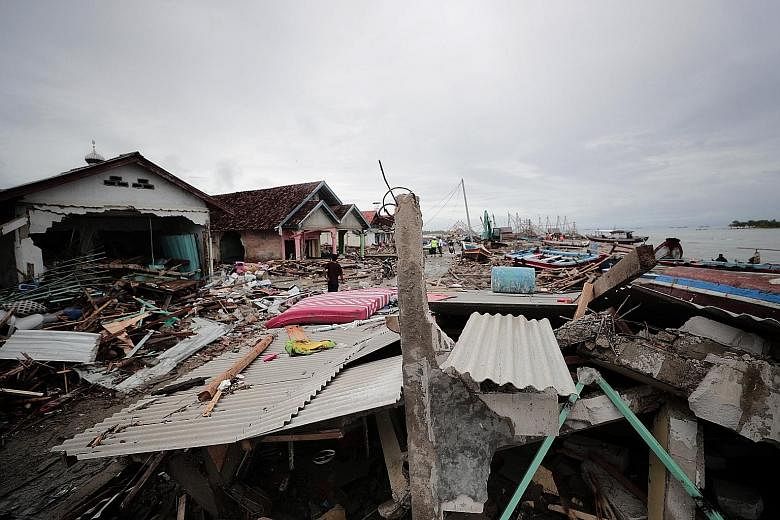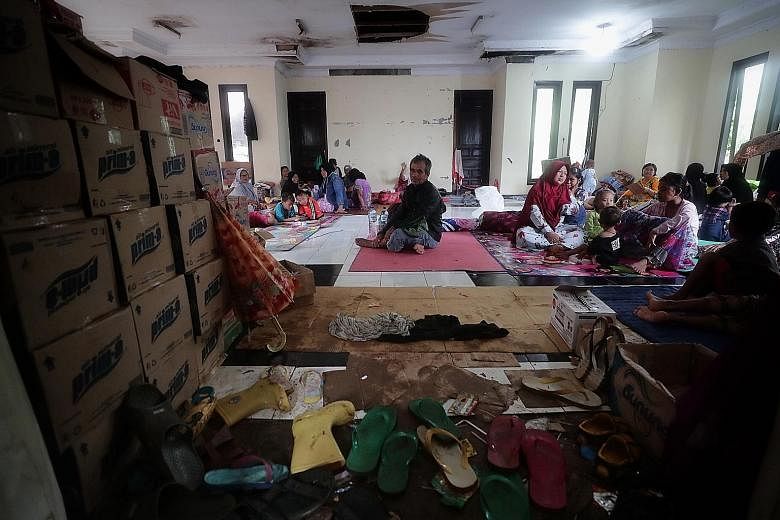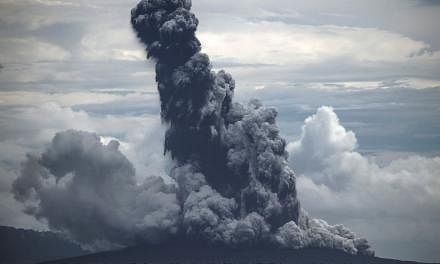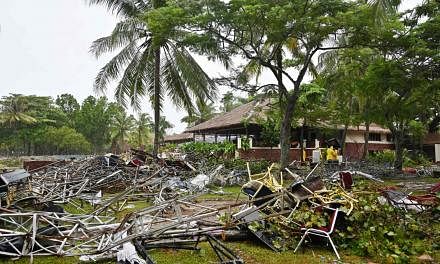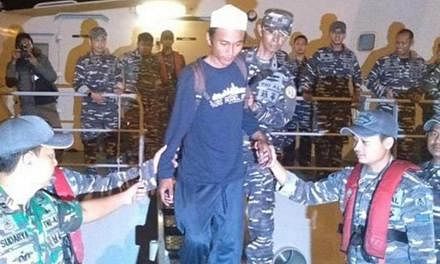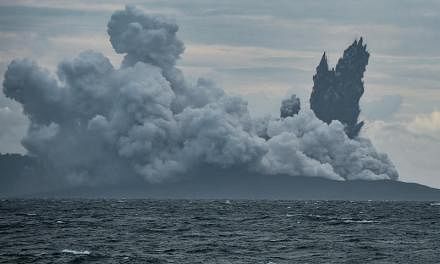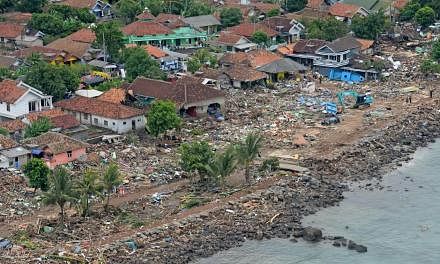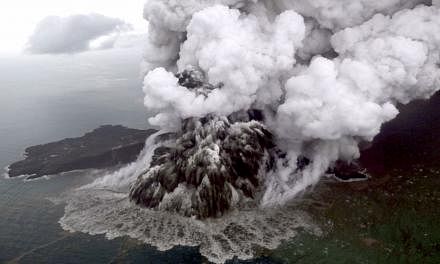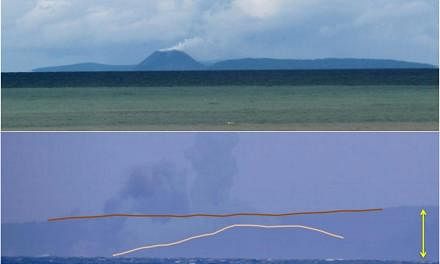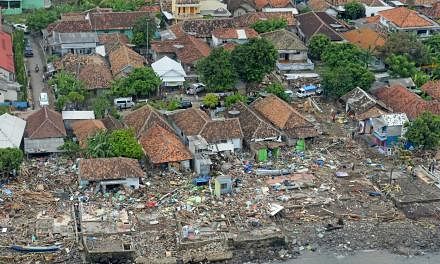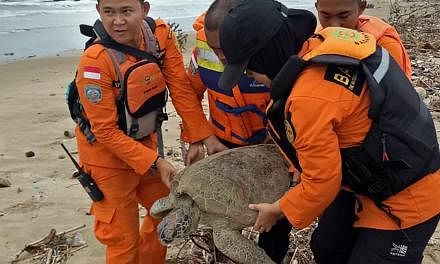Torrential rain yesterday hampered rescue efforts at Indonesia's coastal villages hit by a volcano-triggered tsunami that has claimed more than 400 lives, amid fears that continued eruptions of Anak Krakatau could unleash another destructive wave in Banten province.
An eruption at the rumbling Anak Krakatau - meaning Child of Krakatau - volcano in the Sunda Strait caused a section of the crater to collapse and slide into the ocean, displacing a large volume of water and triggering giant waves as high as 3m last Saturday.
On Tuesday, a fresh eruption at the volcano sent residents fleeing from coastal areas. Locals and officials in Sumur, one of the worst-hit areas, scrambled for higher ground after hearing a booming sound at about 2.40pm local time.
Mr Rudi Suhendar, who heads Indonesia's geology agency, told The Straits Times that between noon and 6pm on Tuesday, the agency's monitoring post near Anak Krakatau detected more tremors and recorded booming sounds.
On the same day, Professor Dwikorita Karnawati, chief of Indonesia's Meteorology, Climatology and Geophysics Agency, appealed to residents in the regions around the Sunda Strait to remain vigilant. "This is not to say it is an emergency situation, but... we ask people not to be within 500m or 1km of the beach," she said.
She warned that the current "extreme weather and high tides", coupled with Anak Krakatau's continued tremors, could potentially trigger another tsunami.
As of yesterday afternoon, the death toll stood at 430, with 1,495 people injured and 159 still missing.
More than 20,000 people have been moved to safer areas, according to the National Disaster Management Agency.
Compounding the misery of the coastal villagers, yesterday's rain was much heavier than the day before, and the sea was still experiencing high tides and strong waves, hampering search and rescue efforts and delaying aid deliveries to isolated villages and evacuation shelters in the affected areas.
"Our teams are seeing many broken bones and broken homes, and people who are very shaken," Mr Arifin Hadi, head of disaster management at the Indonesian Red Cross, told Agence France-Presse. "Indonesians have withstood a string of disasters this year and with them, so much loss and misery."
Hundreds of residents still stranded on tiny islands in the Sunda Strait, which separates Java and Sumatra, will be airlifted or taken by boat to shelters, the disaster management agency said.
Helicopters were dispatched to drop supplies into a handful of hard-to-reach communities along the coastlines of western Java and south Sumatra, it added.
Sergeant Agus Yusuf, a military intelligence officer tasked with keeping order at several villages along Anyer beach, told The Straits Times that talk of rising sea levels and that the volcano may erupt again has caused jitters among the residents.
"More residents have panicked since last night. They are worried that sea water could rise again. You can see houses here are temporarily deserted," he said.
As The Straits Times' team travelled along Anyer beach yesterday, it found that many coastal villages which overlooked the Sunda Strait had turned into ghost towns after residents fled to higher ground.
A few hundred people were seeking shelter at a guesthouse in the Pasauran village when The Straits Times visited yesterday.
Former massage therapist Sarinah, 70, visits her still-intact home once a day to take a shower before returning to the shelter. Asked why she was at the evacuation shelter, she replied: "I don't want to die."
Seven-year-old Wati and her family will call the makeshift evacuation shelter home in the coming days, if not weeks. Her family faces an uncertain future because her fisherman father's boat was badly damaged when big waves slammed into their village last Saturday.
Her mother, identified only as Sani, said most fishing boats were either broken, cracked or missing.
The fishermen have been advised not to venture into the sea.
The giant waves struck without warning on Saturday night.
The current tsunami warning system, put in place after the 2004 disaster, was set up to monitor earthquakes, but not undersea landslides and volcanic eruptions.
A government agency told the BBC that it will build a new warning system that can detect tsunamis caused by undersea landslides.
Mr Iyan Turyana, a spokes-man for the Agency for the Assessment and Application of Tech-nology, told the BBC's Indone-sian service that the installation of the new structure of buoys will start next year.
Last Saturday's natural disaster was the third major one after a series of powerful earthquakes on the island of Lombok in July and August and a quake-tsunami in September that killed around 2,200 people in Palu on Sulawesi Island.
It was exacerbated by an abnormally high tide due to the full moon and heavy downpours ahead of the January peak of the rainy season.
In 2004, a 9.1-magnitude earthquake in the Indian Ocean off the coast of Aceh struck the province on Boxing Day, unleashing waves that left more than 220,000 dead in Indonesia, India, Thailand and Sri Lanka. Indonesia's Aceh province accounted for more than half of the casualties. Thousands prayed at graves and mosques there yesterday to mark the tsunami's 14th anniversary.

